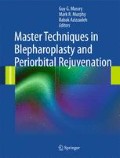Abstract
Festoons are skin folds and ballottable skin edema that occur between the transition zone of the thin lower eyelid skin above and thick cheek skin below. They can cause a dramatic aesthetic disturbance to the lower lid and are difficult to address. We believe that festoons are caused by damage to the skin overlying the area where the horizontally contracting orbital orbicularis oculi muscle converges with the vertically contracting elevators of the upper lip. Skin/muscle flap surgical procedures to correct festoons can be time intensive and yield suboptimal results. Medical therapy has also typically failed to provide significant resolution. Lasers used for skin resurfacing have been a viable option for the treatment of festoons, with carbon dioxide (CO2 ) and Erbium:Yag (Er:Yag) lasers having been used successfully. The treatment of festoons takes advantage of residual thermal energy, which normally accompanies laser tissue ablation. This residual heat causes relatively deep collagen fiber devitalization, and most importantly contraction, which becomes the framework for new collagen formation. Our clinical endpoint for treatment is the presence of no further visible tissue shrinkage with the final laser application. Proper use of the laser requires following laser safety protocols and blending the treated area with the surrounding untreated skin. Frequent follow-up after the procedure allows for better management of the healing process and early recognition of complications. In our experience, modified laser skin resurfacing is a predictable and effective treatment to reduce festoons, which can greatly improve the overall aesthetic outcome in rejuvenation of the lower eyelid–cheek complex.
Access this chapter
Tax calculation will be finalised at checkout
Purchases are for personal use only
References
Furnas DW. Festoons of orbicularis muscle as a cause of baggy eyelids. Plast Reconstr Surg. 1978;61:540–6.
Kikkawa DO, Lemke BN, Dortzbach RK. Relations of the superficial musculoaponeurotic system to the orbit and characterization of the orbitomalar ligament. Ophthal Plast Reconstr Surg. 1996;12(2):77–88.
Mendelson BC, Muzaffar AR, Adams Jr WP. Surgical anatomy of the midcheek and malar mounds. Plast Reconstr Surg. 2002;110:885–96.
Goldberg RA, McCann JD, Fiaschetti D, Ben Simon GJ. What causes eyelid bags? Plast Reconstr Surg. 2005;115(5):1395–402.
Esmaeli B, Prieto VG, Butler CE, et al. Severe periorbital edema secondary to STI571 (Gleevec). Cancer. 2002;95:881–7.
Furnas DW. Festoons, mounds, and bags of the eyelids and cheek. Clin Plast Surg. 1993;20:367–85.
Baker SS, Woodward JA. Carbon dioxide laser blepharoplasty, ptosis correction, and treatment of festoons. In: Alster TS, Apfelberg DB, editors. Cosmetic laser surgery. 2nd ed. New York: Wiley-Liss; 1999. p. 121–39.
Patel CKN. Continuous-wave laser action on vibrational rotational transitions of carbon dioxide. Phys Rev. 1964;136:A1187–93.
Anderson RR, Parrish JA. Selective photothermolysis: precise microsurgery selective absorption of pulsed radiation. Science. 1983;220:524–7.
Walsh Jr JT, Flotte TJ, Deutsch TF. Er:YAG laser ablation of tissue: measurement of tissue ablation rates. Lasers Surg Med. 1989;9:327–37.
Baker SS, Muenzler WS, Small RG, Leonard JE. Carbon dioxide laser blepharoplasty. Ophthalmology. 1984;91:238–43.
David LM. The laser approach to blepharoplasty. J Dermatol Surg Oncol. 1988;14:741–6.
David LM. Laser vermillion ablation for actinic cheilitis. J Dermatol Surg Oncol. 1985;11:605–8.
Weinstein C. Ultrapulse carbon dioxide laser removal of periocular wrinkles in association with laser blepharoplasty. J Clin Laser Med Surg. 1994;12:205–9.
Schomacker KT, Walsh JT, Flotte TJ, Deutsch TF. Thermal damage produced by high-irradiance continuous wave CO2 laser cutting of tissue. Lasers Surg Med. 1990;10:74–84.
Zweig AD, Meierhofer B, Muller OM, et al. Lateral thermal damage along pulsed laser incisions. Lasers Surg Med. 1990;10:262–74.
Lask GP, Keller G, Lowe N, Gormley D. Laser skin resurfacing with the Silktouch flash scanner for facial rhytides. Dermatol Surg. 1995;21:1021–4.
Chernoff G, Schoenrock L, Cramer H, et al. Cutaneous laser resurfacing. Int J Aesth Rest Surg. 1995;3:57–68.
Weinstein C, Alster TS. Skin resurfacing with high energy, pulsed carbon dioxide lasers. In: Alster TS, Apfelberg DB. Cosmetic Laser Surgery. New York: Wiley-Liss, 1996.
Alster TS. Comparison of two high energy, pulsed carbon dioxide lasers in the treatment of periorbital rhytides. Dermatol Surg. 1996;33:541–5.
Alster TS, Garg S. Treatment of facial rhytides with a high-energy, pulsed carbon dioxide laser. Plast Reconstr Surg. 1996;98:791–4.
Kirsch KM, Zelickson BD, Zachary CB, Tope WD. Ultrastructure of collagen thermally denatured by microsecond domain pulsed carbon dioxide laser. Arch Dermatol. 1998;134:1255–9.
Fitzpatrick RE, Ruiz-Esparza J, Goldman MP. The depth of thermal necrosis using the CO2 laser: a comparison of the super pulsed mode and conventional mode. J Dermatol Surg Oncol. 1991;17:340–4.
Waldorf HA, Kauvar AN, Geronemus RG. Skin resurfacing of fine to deep rhytides using a char-free carbon dioxide laser in 47 patients. Dermatol Surg. 1995;21:940–6.
Walsh JT, Flotte TJ, Anderson RR, Deutsch TF. Pulsed CO2 laser tissue ablation: effect of tissue type and pulse duration on thermal damage. Lasers Surg Med. 1988;8:108–18.
Hobbs ER, Balin PC, Wheeland RG, Ratz JL. Super pulsed lasers: minimizing thermal damage with short duration, high irradiance pulses. J Dermatol Surg Oncol. 1987;13:955–64.
David LM, Lask GP, Glassberg E, et al. CO2 laser abrasion for cosmetic and therapeutic treatment of facial actinic damage. Cutis. 1989;43:583–7.
Hruza GJ. Skin resurfacing with lasers. Fitzpatrick’s J Clin Dermatol. 1995;3:38–41.
Cotton J, Hood AF, Gonin R, Beeson WH, Hanke CW. Histologic evaluation of preauricular and post auricular skin after high energy, short-pulse carbon dioxide laser. Arch Dermatol. 1996;132:425–8.
Fitzpatrick RE, Tope WD, Goldman MP, Satur NM. Pulsed carbon dioxide laser, trichloroacetic acid, Baker-Gordon phenol, and dermabrasion: a comparative clinical and histologic study of cutaneous resurfacing in a porcine model. Arch Dermatol. 1996;132:469–71.
Monafo WW. Initial management of burns. N Engl J Med. 1996;335:1581–6.
Author information
Authors and Affiliations
Corresponding author
Editor information
Editors and Affiliations
Rights and permissions
Copyright information
© 2011 Springer Science+Business Media, LLC
About this chapter
Cite this chapter
Scheiner, A.J., Baker, S.S. (2011). Laser Management of Festoons. In: Massry, G., Murphy, M., Azizzadeh, B. (eds) Master Techniques in Blepharoplasty and Periorbital Rejuvenation. Springer, New York, NY. https://doi.org/10.1007/978-1-4614-0067-7_19
Download citation
DOI: https://doi.org/10.1007/978-1-4614-0067-7_19
Published:
Publisher Name: Springer, New York, NY
Print ISBN: 978-1-4614-0066-0
Online ISBN: 978-1-4614-0067-7
eBook Packages: MedicineMedicine (R0)

